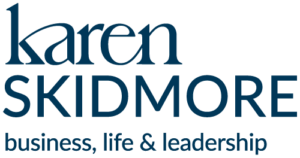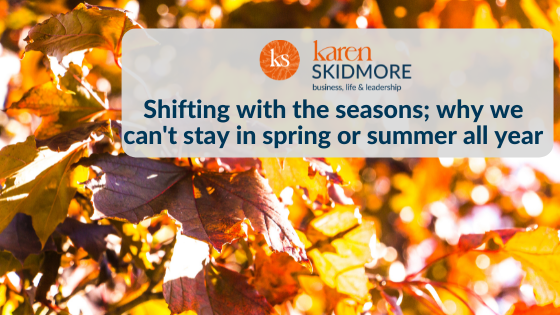
by Karen Skidmore | 09,21 | Ebb & Flow, Leadership
image
Hi Karen
Walking into my Plotting Shed this morning, there was a distinct chill in the air. For the first time this season, I shuddered and realised it was time for ceremonial switching on of the wall heater.
I love the shift in seasons. It reminds me that change is always happening.
No matter how much we want to stay in the place we’re in, we’re always moving forwards, having to adjust to what comes our way.
There is so much focus on our wardrobe shifts, packing away our summer clothes and dusting off our autumn boots, but to me season shifts are so much more; in life, business and leadership.
As the seasons shift, so do we.
Yes, there are the obvious shifts that take place as we age.
But there are the more subtle shifts as we flow in and out of love for the work that we do.
There’s often a belief that if we lose our mojo that it’s a bad thing; we must stay motivated and have passion for what we do at all times. For if we don’t, then we must be doing something wrong.
Is that really the case?
As I approach my autumn years in age (now 52), I’m embracing the subtle shifts of slowing down, whilst still able to make a bigger impact.
And I recognise that not feeling passionate about what I am doing every day is absolutely OK.
Look at our seasons. Autumn chills our air, which signals for our trees to lose their leaves. And when Winter arrives, our barren trees give us the impression that all is dead.
However, it is Winter that drives the power of our Spring and Summer. For you to feel full of creativity and energy, it is those quiet, reflective, quiet times that give you the fuel to spring forward.
If you were to stay in Spring and Summer energy all year round, you’d be exhausted and eventually burn out. And yet, this is the expectation that so many of us have about our work and leadership paths.
If you want to learn more about my midlife journey and how I run my own business around my own seasonal shifts, then I have two podcast interviews that have been released.
Rachel Lankester’s Magnificent Midlife Podcast is now in its third year, so I was delighted to be asked to share how I make the most out of my midlife, and share my journey in figuring out what kind of business really suited me.
Plus, I was featured on Joy Burnford’s The Confidence Conversation on how I fit life and work together, and shift my energies to help me step up when I need to.
Would love to know how you are embracing the season shifts; whether it’s simply a change in wardrobe, or that you consciously shift up or down your gears at this time of year.
In the meantime, if you want to find out more about how to embrace your midlife shifts, then join us for our two day Embrace Festival that’s happening on 21st & 22nd October.
Thank you for reading. Until next time, do less, be more, play bigger.

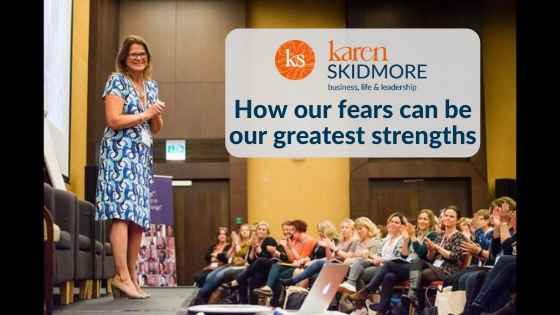
by Karen Skidmore | 09,21 | Leadership, Stories, inspirations & thoughts for the day
Back in 2017 … those pre-covid days of being able to attend conferences with hundreds of other people! … I had spent an incredible weekend at the One Woman Conference.
There were 400+ women at this event and I had the honour of being invited up on the stage as one of the finalists of the Lead The Change awards 2017, voted by the community as someone who most embodied the One of many SoftPower Leadership principles.
Having spoken on many stages, it has to have been one of my most nerve wracking performances. Somehow sharing my personal story and the vulnerabilities I’d faced (and was still facing!) was nerve racking. ,
In the run up to the conference, I reflected on what it took to step in to our potential to make a difference, and what it was about me that represented being a leader.
When you spend time by yourself and unconnected with people outside of your immediate family (and let’s be honest, we’ve all plenty of this opportunity for this over the past 18 months!), it’s easy to feel that whatever journey you are on, that what’s ahead of you is too steep or too rocky or that your goal isn’t clear and is shrouded in mountain cloud.
And this was the big lesson I shared on stage that day.
That there are times, particularly when you are alone, that fear and doubt and worry creep up, sometimes from nowhere, and take hold of us.
My fear and doubt appears as a gentle tight grip on the inside of my throat; almost like a child’s hand trying to silence me.
Your fears and doubts will appear in different places. Perhaps a knot in your stomach or a pain on your left side or a buzzing sensation at the back of your skull.
For the years running up to working with One of many, I had used this feeling in my throat to pull me back, like a bungee cord. I’d come up with an idea, reach for it and then the bungee cord would snap me back so that I’d either give up on the idea or just do a smaller version of it. And this happened a lot in the years I was recovering from my burn out, often very afraid of getting sick again.
My journey with the incredible mentors who make up One Of Many, Joanna Martin, Annie Stoker and Susie Heath, had allowed me to now feel into my uncomfortableness … the feeling of vulnerability … the feeling of shame, guilt and whatever my inner shit threw up at me at the time I want to do bigger things and become a bigger version of myself.
That gentle tight grip on my throat became my sign that it’s the right thing for me to do.
And as I stood up on that stage, I felt it appear … so I knew what I had to share was the right thing for me to have shared that day!
Feeling in to this experience of identifying where in our body we feel emotions is incredible powerful. It slows down our over thinking, and often over catastrophising, of the situation we are faced with; whether that’s a difficult conversation, a challenge at work or a relationship with a friend or family member.
Do you feel into your uncomfortableness of fear, doubt, shame or guilt … whenever it appears … and see it as a power? As a sign that you may need to hear a message of stepping up, to challenge?
I’d love to know if you do this already, perhaps even on a subconscious basis, not realising that you are doing it.
Because I’ve come to now feel these uncomfortable moments not as a bungee cord as I had done the years previously. I’ve learnt to slow down, take a moment and feel into knot or the pain or the grip or the buzz because I know now it’s probably trying to tell me something.
That bungee cord pulling me back to safety is all very well. Because, after all, safe is lovely place to be, particularly on a warm, cosy Sunday afternoon when you want to snuggle up on the sofa with a good book or film.
But if you want to make a bigger impact on this world around us, then safe will only keep you safe. It doesn’t allow us to take risks and stretch us into our potential.
As Brene Brown so eloquently puts it,
“Vulnerability is the birthplace of innovation, creativity and change.”
So let us get vulnerable and, more importantly, feel vulnerable because I know this has the potential to let out the leader that’s within you, too.
Thank you for reading. Until next time, do less, be more, play bigger.

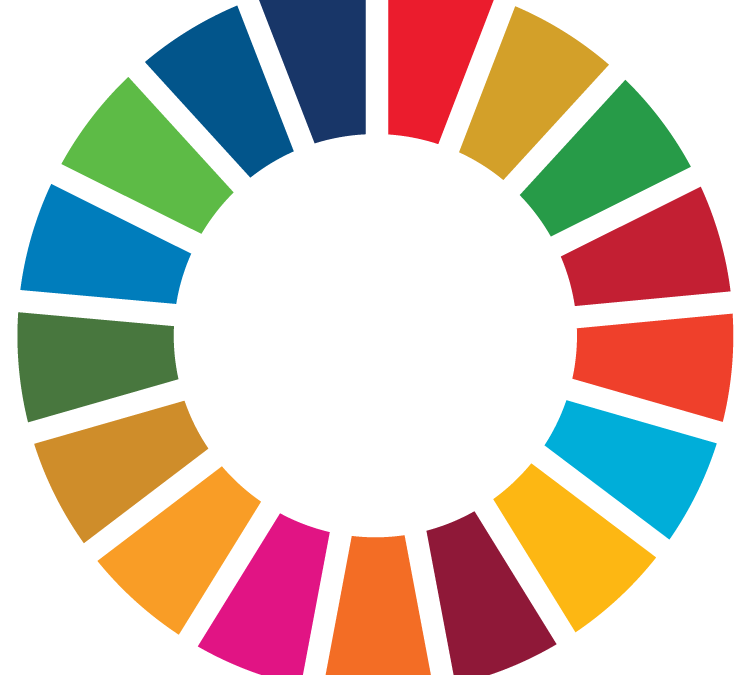
by Karen Skidmore | 05,20 | Impact Report, Leadership
Last year I decided to align my business so it can become a real force for good and, in particular, in how I can contribute towards the Global Goals for Sustainable Development.
(You can read about these SDGs here if you want to know more https://www.globalgoals.org/)
One way I have decided to do this is to use the Accountability Reports that each of our Momentum members posts each week to donate to specific causes I want to support. I use an organisation called www.B1G1.com which allows me to give to charities easily through a process of “whenever we do this, we make something great happen in our world'”.
As of next week, I have decided to up the value of each accountability report from $1 to $2, which means for every Accountability Report they post over the next 90 days, they have the potential of helping me donate $408 by the end of August.
There’s nothing like using an additional emotional reason to help keep our members motivated to post weekly Accountability Reports. Plus it helps keep me committed to my giving goals throughout the year!
I have just decided on three projects that I would like to support and I’ve just asked my Momentum members to vote on the one we will be supporting for this next 90-day cycle.
And, I’ll admit … it was bloody hard to pinpoint three projects that I wanted to support this time around.
With so much attention going on raising funds for our NHS right now, I got confused about where I should be focusing my impact right now. With so many charities needing our support at this current time, how do any of us decide who we support?!?
Should I be moving away from my SDG goals and B1G1 commitment, and switch?
We can’t support every charity. As much as we all like to give when we can, we just don’t have the funds to give to everyone, do we?
And yet if we stay undecided, we end up supporting no one.
Wrestling with this dilemma this morning has made me realise why it’s important for us all to spend time to keep connected with the vision we have for the future. Our vision is our guiding light; our North Star if you like.
And this morning I reminded myself of my vision.
“Imagine a world where our global political and economic drivers are deeply connected to our spirituality and humanity; a world where money, creativity and impact are aligned to give us a planet where every person, animal and ecosystem thrives.”
Reading this again helped me see why I needed to continue to support the two SDGs that I believe will support my vision for the future:
Gender Equality – the empowerment of women around the world to not only be safe but to have choices in how they live, work, contribute and lead.
Responsible Consumption and Production – supporting businesses that choose to do good, be good and treat our planet with the respect that it deserves.
Once I reconnected with my vision again, the choice of what projects to present became easy. I was able to select based on my top-down criteria.
These are the three projects I presented to my members today. Although your vote can’t be counted (Momentum members only, I’m afraid!), I’d love to know which project you’d vote for if you had to.
And if you find the choice hard, I get it. Choosing who we support can be tough and I hope by sharing this story with you today it helps you make your decisions on who to give to and how to do it.
The important thing I believe is that we DO make a decision.
Because, if we stay undecided, we end up supporting no one.
Project 1: Train a Farmer in Sustainable Farming
Logging the rainforest is a dangerous job that takes you away from your family and compromises the water you depend on for life. Loggers in Indonesia know this but have no alternative livelihood. By teaching farmers sustainable farming techniques like crop rotation, using organic fertilizers and pesticides, these farmers no longer have to practice slash and burn agriculture, but can farm the same land year after year. Train one farmer in sustainable farming techniques and you will protect the rainforest and improve community well-being.
Project 2: Fund a Social Entrepreneur
Fund a social entrepreneur and help to make a change through financial support, which is inclusive of the start-up costs needed to set up a pilot initiative or business. Seed funding, especially the costs of setting up a pilot are critical in the early days of a start-up social entrepreneur. These entrepreneurs are primarily solving social problems around livelihood, education, health & wellbeing, environment, agriculture and waste management, leading to long-term solutions for problems occurring daily in India.
Project 3: Empower Women with Literacy and Business Skill
Five Talents is a microfinance organization that uplifts the world’s poorest families. Your support helps women build their own businesses through education, business training and access to financial services, which supports their families and entire communities – paving the way for a sustainable future. Poverty levels in Uganda are high, access to electricity and education are limited and the country relies heavily on agriculture. This project works with the community to address their specific needs and find ways to diversify their incomes.
Until next time,

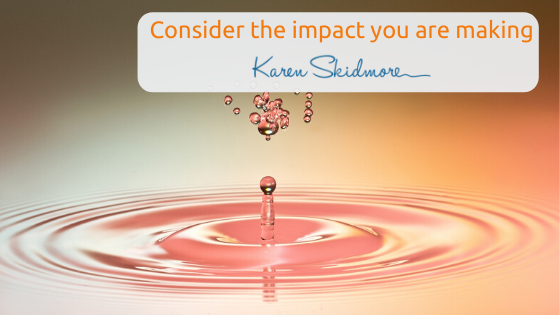
by Karen Skidmore | 02,20 | Impact Report, Leadership
How often do you stop and consider the impact you are making?
Not how many sales you’ve made this month. Or how many new leads you’ve got. Or even how much money you’ve made.
But how your business is making a difference.
Now before you begin to wonder whether this is an either/or question, it’s not. Money is still an important energy in your business, whether you are a commercial, social or charitable business. But for us to thrive whilst growing a business, we need the energies of money, creativity and impact.
The reason why I wanted to share the important message of impact today was that I was delighted to see one of my Momentum members featured in her local newspaper. Linda is a transformational life coach who came to work with us last summer to help get her business back on track. It was apparent very quickly that what Linda needed help with was to build up her confidence and FEEL more in tune with what she was offering, rather than focus on DOING lots of marketing tactics.
This may sound a little woo woo but, in my experience, we can not grow our business sustainably unless we’ve connected energetically with our goals and the plans on how to get there.
It doesn’t matter how wonderful your new marketing funnel is. If you’re not energetically connected with it or feel at all heavy about the whole process, it ain’t going to work!
Part of this connection process is understanding the importance of impact in our business and how it serves not just the people we are impacting, but also ourselves as we stretch into our potential.
We helped Linda unlock this and find focus on how she could achieve this in her business. She took an idea of starting up a Chattie Cafe, events for people who may feel lonely in the community, and got funding from the Co-op Local Community Fund and Lions Club to keep them going on a regular basis.
Now, for some people, they may consider a project like this a distraction from the act of having to make sales. But this isn’t an either/or opportunity.
The confidence Linda has found in leading this project has not only helped and provide critical wellbeing support for her local community but also helped her step up her own coaching business and establish herself as a recognised member of her local community. She got herself ‘out there’ without having to be always marketing her commercial business.
It’s what I would call a win win win! A win for the local community, a win for Linda’s confidence and leadership skills and a win for Linda’s paying clients.
The energy of impact is needed to ensure you align your drive to make money, with who you are as a person and the difference you want to make.
This is what I call True Profit Business. If you want to know, you can get a copy of my book over on Amazon.
Until next time, do less, be more, play bigger.

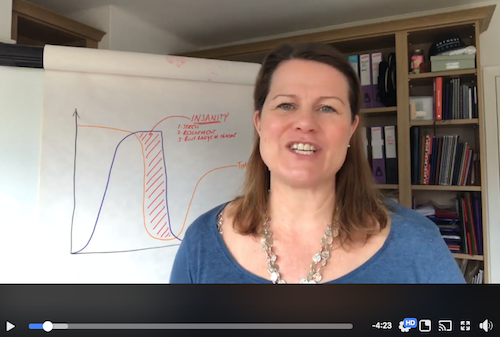
by Karen Skidmore | 03,18 | Leadership, Stories, inspirations & thoughts for the day
Let’s talk about the words YES and NO. Does saying YES really lead you to the right opportunities?
Or does it lead you to the world of insanity?
YES and NO. Such definite answers. Great words for making decisions. And yet say YES more often than you’ve got time for, and this can break your entrepreneurial success.
The Yes Paradox. Does saying YES really lead you to the right opportunities? Or does it lead to the world of insanity? Yes and No. Such definite answers. Great words for making decisions. And yet saying one of the words more than the other, can make or break your long term entrepreneurial success. Let me know what you think about saying YES in the comments below. Are you a YES or a NO person? And why?
Posted by Karen Skidmore – True Profit Business on Wednesday, March 7, 2018
When you first start out, your world is your oyster. The adventure is exciting and terrifying all at the same time. You may or not have a clear vision at the beginning but one thing you have for sure is time.
With no clients or customers, you have plenty of time to work ON your business. And this is where saying YES can be incredibly powerful.
Saying YES opens up yourself to opportunities. Allows you to explore new avenues of potential. Gives you the chance to try out different things which can feed your creativity and clarity.
But there comes a certain point that the YES get too much.
As you say YES to another thing. And then another thing, your time gets eaten up.
Until your time is at rock bottom and you’ve reached the place of INSANITY.
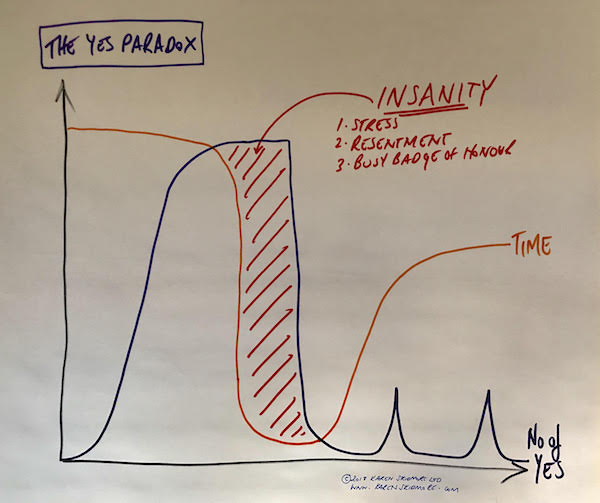
1) You’re stressed because you’ve taken on too much. And I don’t care what you read about multi-tasking, it simply doesn’t work. Modern society has tricked us into thinking that we can do lots of things at the same time; particularly women.
But the truth is PRIORITIES was never meant to be a plural. It’s an oxymoron that we have PRIORITIES. Only one thing can have our conscious attention at the time.
2) This leads to resentment. As you stretch yourself further and further, it’s easier to blame other people and other projects who suck up your time. All it takes is one thing not to go right and it puts your schedule out on everything else for days or weeks.
3) You then proudly wear The Busy Badge of Honour. If someone asks us how we are, how often do we proudly answer, “Oh, I’m busy. So busy.” And the other person answers, “That’s great. So am I.” which simply confirms to us that being busy is the right thing to be.
But it’s simply not.
This place of insanity keeps you sucked in under to-do lists and deadlines created by other people. You react. You juggle. You try to work harder. But you just never get where you want to go.
Knowing when to start saying NO is critical to your long-term success. If you have a vision and a plan to play a bigger game, NO has to be the answer to the majority of questions asked of you.
Because by saying NO, it allows the right YES to be said at the right time.
So I hope this helps you reflect on what you’re saying YES to right now and what you’re saying NO to right now.
Thank you for reading. Until next time, do less, be more, play bigger.















